Geoelectrical deep soundings in Southern Africa using the Cabora Bassa power line
Article Sidebar

Vols. 1-18 (1924-1944), ISSN 0044-2801
Main Article Content
Abstract
Geoelectrical deep soundings with electrode spacings between 30 and 1250 km have been carried out from 1973 to 1975 in southern Africa using the Cabora Bassa power line. At several sounding stations (Schlumberger and bipole-dipole arrays) the electric potential differences have been recorded in different directions. For short current-electrode spacings (< 200 km) the direction of the electric field is nearly perpendicular to the direction between the current electrodes whereas it becomes more or less parallel for large electrode spacings (> 400 km). A possible cause for this rotation of the field may be a dyke system observed in the granitic crust.
 ARK: https://n2t.net/ark:/88439/y065100
ARK: https://n2t.net/ark:/88439/y065100
Permalink: https://geophysicsjournal.com/article/216
Article Details
References
Bloch, S., Hales A.L., Landisman, M. (1969) Velocities in the crust and upper mantle of southern Africa from multimode surface wave dispersion. Bull. Seism. Soc. Am. 59:1599-1629
Blohm, E.-K. (1972) Die Methode der geoelektrischen Tiefensondierungen mit groBen Elektrodenentfernungen. Doctoral thesis, Technical University Clausthal, 71 pp.
Blohm, E.-K., Plathe, H. (1970) Geoelectrical deep sounding in the Rhinegraben. In: Illies, H. (Ed.) Graben problems (Intern. Upper Mantle Proj. Scien. Rep. 27), pp. 239-242, Stuttgart
Brace, W.F. (1971) Resistivity of saturated crustal rocks to 40 km based on Laboratory results. In: Heacock, J.G. (Ed.) The structure and physical properties of the Earth's crust, AGU Geophys.
Monograph, Vol. 14, pp. 243-255
De Beer, J.H., Gough D.I., Van Zijl J.S.V. (1975) An electrical conductivity anomaly and rifting in southern Africa. Nature 255:678-680
Dennert, U. (1977) Programm zur direkten Interpretation geoelektrischer Sondierungskurven fur horizontal geschichteten Untergrund. Archiv NUB
Fairhead, J.D., Reeves, C.V. (1976) Teleseismic delay time, seismicity and inferred thickness of the African Lithosphere. Earth Planet. Sci. Letters, submitted for publication
Homilius, J., Blohm, E.-K. (1973) Modell zur Interpretation der geoelektrischen Tiefensondierung im Rheingraben 1967. J. Geophys. 39:441-459
Keller, G.V. (1971) Electrical studies of the crust and the upper mantle. In: Heacock, J.G. (Ed.) The structure and physical properties of the Earth's crust, AGU geophysical monograph no. 14, Washington
Reeves, C.V., Hutchins, D.G. (1975) Crustal structures in central southern Africa. Nature 254:408-410
Schmucker, U. (1974) Erdmagnetische Tiefensondierungen mit langperiodischen Variationen. Protokoll uber das Kolloquium "Erdmagnetische Tiefensondierung" in Grafrath (FRG)
Van Zijl, J.S.V. (1969) A deep Schlumberger sounding to investigate the electrical structure of the crust and upper mantle in South Africa. Geophysics 34:450-462
Van Zijl, J.S.V. (1976) Electrical Studies of the deep crust in various tectonic provinces of Southern Africa. Paper, read on ONR Symposium on the Nature and Physical Properties of the Earth's Crust, Vail, Colorado, August
Van Zijl, J.S.V., Hugo, P.L.V., De Bellocq, J.H. (1970) Ultra deep Schlumberger sounding and crustal conductivity structure in South Africa. Geophys. Prospecting 18:615-634
Van Zijl, J.S.V., Joubert, S.J. (1975) A crustal geoelectrical model for South African Precambrian granitic terrains based on deep Schlumberger soundings. Geophysics 40:657-063
Zohdy, A.A.R. (1970) Geometric factors of bipole-dipole arrays. U.S. Departement of Geological Survey Bull., 1313-B, 26 pp.











